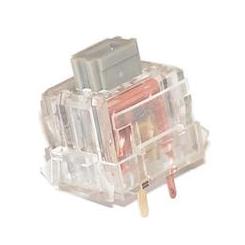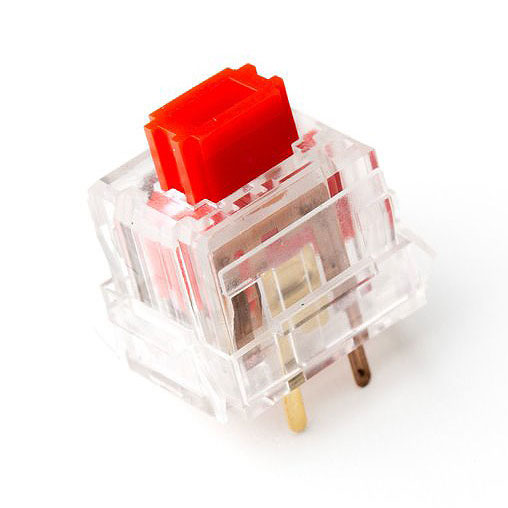Mechanische Schalter
Mechanische Schalter
Vorwort
Dies ist unsere zweite Version des Artikels über die mechanischen Schalter. Der erste wurde im Jahr 2014 geschrieben. Seitdem hat sich die Welt der Mechanik sehr verändert, und unsere Vorstellung über die Schalter auch. Im Vergleich zur ersten Version wurde der zweite Artikel sehr erweitert und vervollständigt. Wir haben die strikte Trennung von Schreib- und Spieltastaturen weggelassen, da diese Trennung nicht mehr gerechtfertigt ist. Es gibt Programmierer, die Cherry MX Black lieben, und Spieler, die Cherry MX Blue mögen. Stattdessen haben wir versucht, die Schalter aus der Sicht eines normalen Benutzers zu beschreiben, da wir im Laufe der Jahre viel Erfahrung mit sehr unterschiedlichen mechanischen Tastaturen und Schaltern gesammelt haben.
Die meisten Schaltermodelle wurden den Cherry MX- oder den ALPS-Schalter nachgemacht, daher werden wir versuchen, die beiden genauer unter die Lupe zu nehmen, während für die nachgemachten Kopien ein kurzer Exkurs ausreichen würde.
Inhaltsverzeichnis
Cherry MX-Schalter
Cherry MX-Schalter wurden erstmals am 7. November1983 von der deutschen Firma Cherry vorgestellt. Zu Anfang waren nur Linearschalter verfügbar. Durch verschiedene Eigenschaftskombinationen - Druckkraft, taktile Rückmeldung (oder Verzicht darauf), Nutzung oder Nicht-Nutzung einer Klick-Mechanik - wurden viele neue Schalter-Modelle entwickelt; optisch werden sie durch unterschiedliche Stößelfarben (stem color) differenziert.

Cherry MX-Schalter sind der Qualitätsstandard in der Industrie. Die vergoldeten Kontakte unterliegen keiner Korrosion und rosten nicht mit der Zeit, man kann sie sogar mit Kaffee oder Cola eingießen, anschließend unter fließendem Wasser spühlen, trocknen und weiterverwenden.
Während der Produktion wird besonders auf Gründlichkeit und Präzision Wert gelegt, wodurch Fehler, Ausfälle, Doppelklicks, Geräusche und andere unangenehme Merkmale billiger chinesischer Klone vermieden werden.
Cherry MX RGB-Schalter
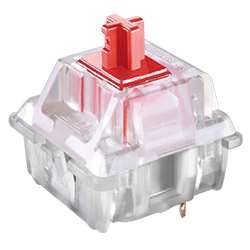
2014 wurde ein Schalter-Typ mit einem transparenten Körper vorgestellt: der RGB-Schalter. Diese Schalter wurden gemeinsam von Corsair und Cherry im Rahmen eines Projekts zur Herstellung einer vollständigen Tastaturbeleuchtung entwickelt. In den ersten sechs Monaten nach dem Projektstart, hatte Corsair das ausschließliche Recht, solche Tastaturen zu produzieren. Das Prinzip ist recht einfach: Die Diode wird mit der Leiterplatte verlötet. Dank des transparenten und Licht-streuenden Gehäuses dringt das Licht direkt unter den Tasten ein und beleuchtet den gesamten Innenraum der Tastatur.
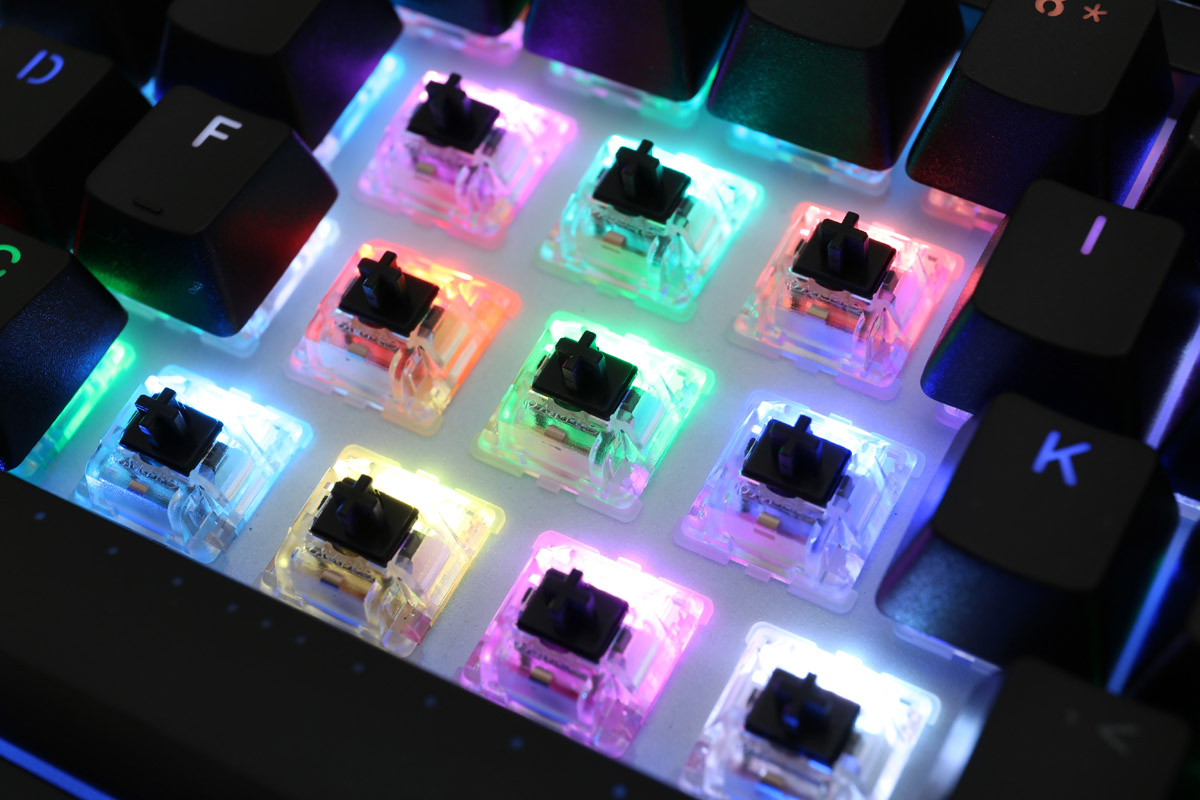
Cherry MX Brown (taktil)
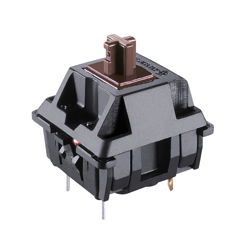
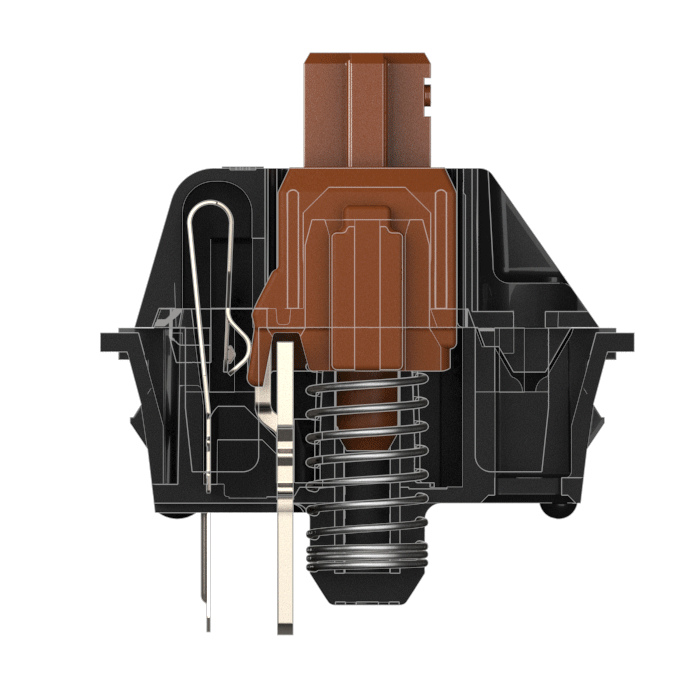
Sound abspielen
Sie sind die “Schalter für alles”: Im Vergleich zum Cherry MX Blue und zum Cherry MX Green sind sie recht leise, weil sie nicht klicken; gleichzeitig aber ist der Reaktionspunkt gut zu spüren: Man merkt, wann es Zeit ist, die Taste loszulassen, ohne sie ganz runterdrücken zu müssen. Das ist sehr angenehm, vorallem für diejenigen, die viel schreiben. Wenn man also nicht genau weiß, was man braucht, kann man guten Gewissens zu den Cherry MX Brown greifen.
- Als Einsteigermodell
- Für Amateurspiele
- Für Zuhause
- Fürs Büro
Cherry MX Blue (taktil, klickend)
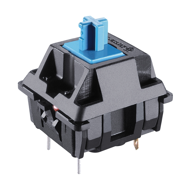
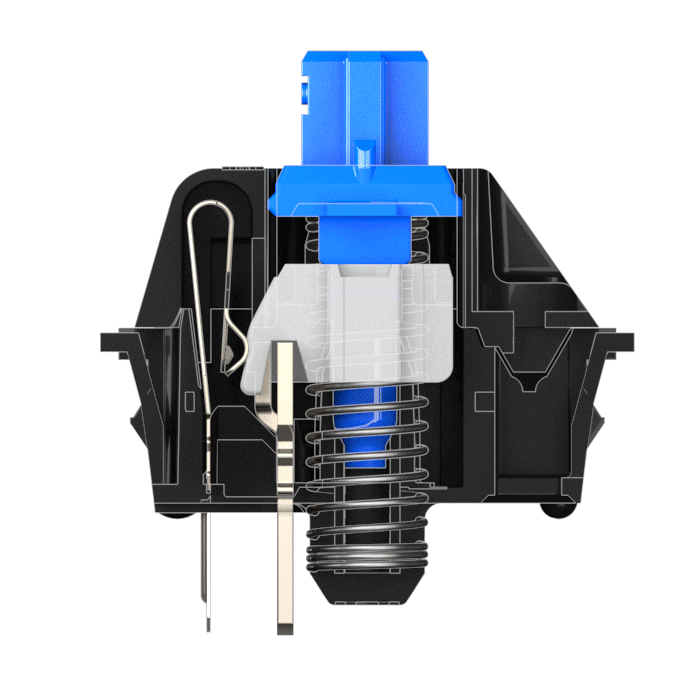
Sound abspielen
Cherry MX Blue ist vor allem bei Fans mechanischer Tastaturen der absolute Favorit. Das Klicken ähnelt dem einer Schreibmaschine, aber es ist weniger laut und “knirschend". Außerdem lässt sich der Triggerpunkt des Schalters beim Drücken noch deutlicher spüren. Somit ist das Tippen auf diesen Schaltern noch komfortabler als auf den Cherry MX Brown. Außerdem lassen sie sich recht leicht anschlagen, sodass die Finger beim Tippen nicht müde werden. Es gibt aber auch Nachteile: In einem Gemeinschaftsraum ist die Verwendung einer solchen Tastatur wahrscheinlich keine gute Idee: Das Klick-Geräusch kann Ihre Nachbarn im Arbeitsbereich stören. Manche Nutzer meinen außerdem, dass aufgrund des großen Abstands zwischen den Hauptbetätigungspunkt und dem Rückzugspunkt, schnelle, häufige Anschläge möglicherweise nicht immer verarbeitet werden, sodass Cherry MX Blue für Spiele nicht so gut sind. Diese Meinung wird allerdings nicht von allen geteilt. Hier entscheiden oft auch das subjektive Gefühl und persönliche Vorlieben.
- Fürs Büro - allerdings nur ohne empfindliche Kollegen
- Für Zuhause - so lange keiner nebenan schläft
- Für erfahrene Schreiber
- Für Freunde von soften Klicks
Cherry MX Red (linear)
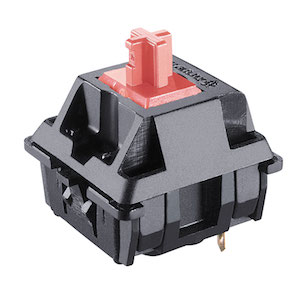

Sound abspielen
Cherry MX Red sind vor allem bei Spielern sehr beliebt. Diese Schalter werden auf jeden Fall am häufigsten für Spiele benutzt. Sie sind linear und eignen sich für schnelle Mehrfachanschläge. Im Gegensatz zum Cherry MX Black (45 g gegen 60 g) sind sie auch recht leicht zu drücken. Das ist sowohl ein Vorteil wie auch ein Nachteil: Die Finger ermüden nicht so schnell, aber man gerät auch schneller versehentlich auf einen falschen Knopf. Das ist Typsache: man kann die Genauigkeit des eigenen Anschlags trainieren oder auch daran arbeiten, die Fingermuskulatur zu stärken.
Der Cherry MX Red ist die “zärtlich-geschmeidige” Variante, weshalb auch nicht nur Gamer auf sie setzen. Auch reguläre Arbeit wird mit ihnen zum echten Vergnügen: Beim Tippen, schweben ihre Finger quasi über die Tastatur.
- Für Gamer mit eher schwerfälligen Fingern oder für leichtfälligere Arbeit
- Im Arbeitsumfeld, damit man die Umsitzenden nicht stört
- Für entspanntes und geschmeidiges Tippen
- Für Zuhause
- Fürs Office
Cherry MX Silent Red (linear)

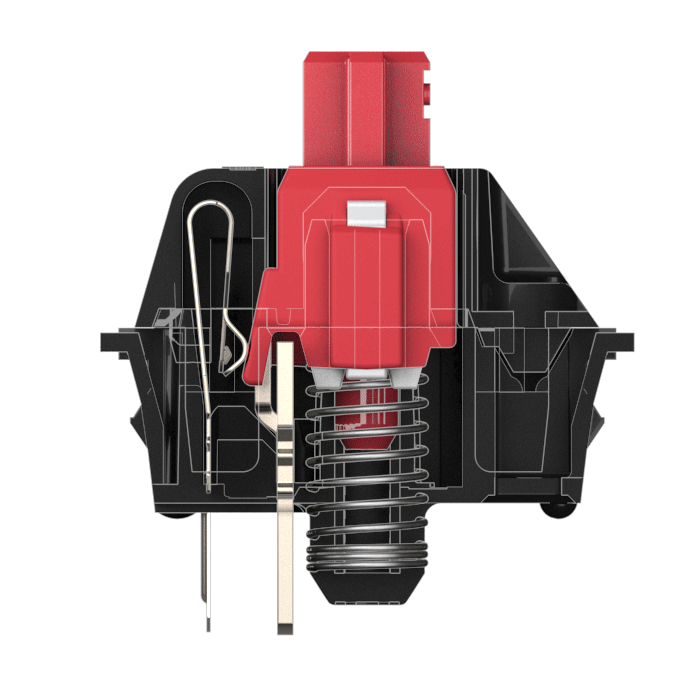
Sound abspielen
Gefertigt in Zusammenarbeit mit Corsair und vorgestellt im Jahr 2015. Das ist der Cherry MX Red für diejenigen, die absolute Ruhe bei der Arbeit brauchen. Im Gegensatz zum ausgewogenen Cherry MX Red ist hier bereits ein Übermaß an Sanftheit vorhanden: Im Schalter ist ein schallabsorbierendes Pad installiert, das den Kontakt von Kunststoff auf Kunststoff sowohl beim Drücken der Taste als auch beim Loslassen akustisch dämpft. Das Gebrauchsgefühl ist dadurch manchmal vage, etwa so, als würde man in ein kleines Kissen drücken. Für viele Nutzer ist es genau diese “Weichheit”, die den Schalter so attraktiv macht. Der Tastenanschlag lässt sich mit dem Unterschied eines Drucks auf einer festen Oberfläche - zum Beispiel ein Tisch - zu einer weichen Struktur - eine Handfläche - vergleichen. Durch diesen weichen Anschlag hat der Cherry MX Silent Red einen mächtigen Vorteil: Die Tastatur wird dadurch fast hundertprozentig lautlos.
- Fürs Büro mit leicht reizbaren Kollegen
- Für Gamer mit aggressivem Tippverhalten - die Tasten dämpfen die Einschläge
- Für Heimarbeit, wenn nebenan geschlafen wird
- Wenn Sie etwas Neues und Ungewöhnliches wollen
Cherry MX Black (linear)
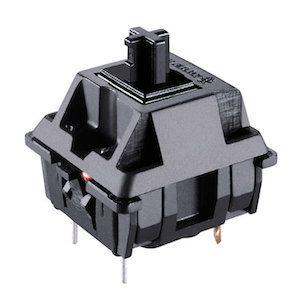
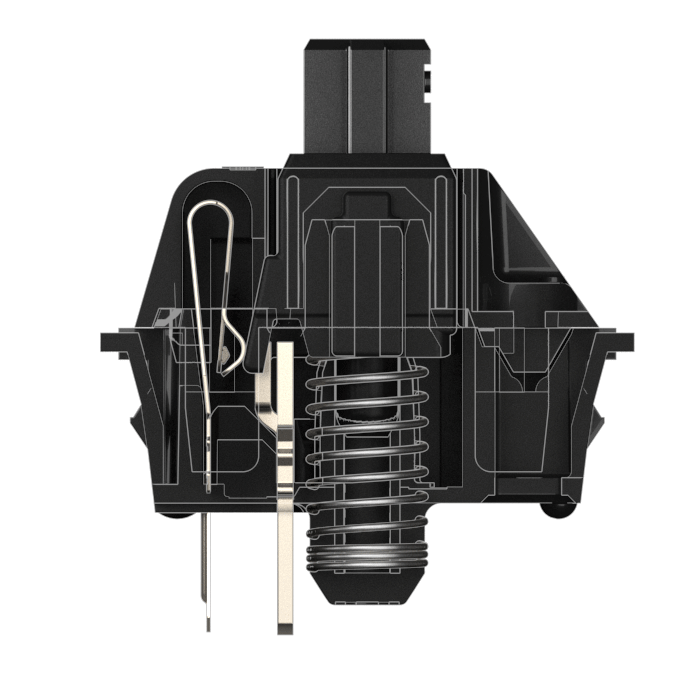
Sound abspielen
Der Cherry MX Black wurde erstmals 1984 eingeführt und ist somit einer der ältesten mechanischen Schalter. Sie sind auch die widerstandsfähigsten in der Produktlinie. Das ist oftmals gewöhnungsbedürftig, da für die Bedienung der Tastatur mehr Kraftaufwand erforderlich ist. Andererseits sorgt dieser Umstand für erhöhte Präzision, da versehentliche Fehlanschlage nahezu ausgeschlossen sind. Dieser kräftige Wiederstand gibt der Tastatur einen besonderen Touch, für den viele Nutzer den Cherry MX Black besonders mögen. Gerade bei Spielern sind sie sehr beliebt, denn beim Gaming schnelles und genaues Drücken in kurzen Zeitspannen erforderlich ist, dabei werden ihre Finger den erhöhten Widerstand, kaum merken.
- Spieler
- Präzisionsschreiber
- Heimbetrieb
Cherry MX Clear (taktil)
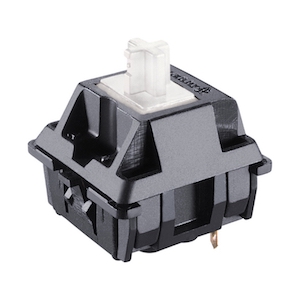
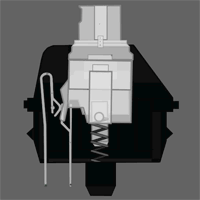

- Erfahrene Fans mechanischer Tastaturen, die etwas Neues ausprobieren möchten
- Für diejenigen, die “Klicks” nicht mögen und taktilen Widerstand als angenehm empfinden
- Für starke Finger
- Im Heimbetrieb
- Im Office
Cherry MX Green (taktil, klickend)
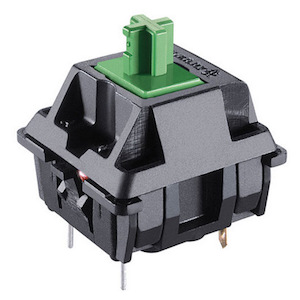
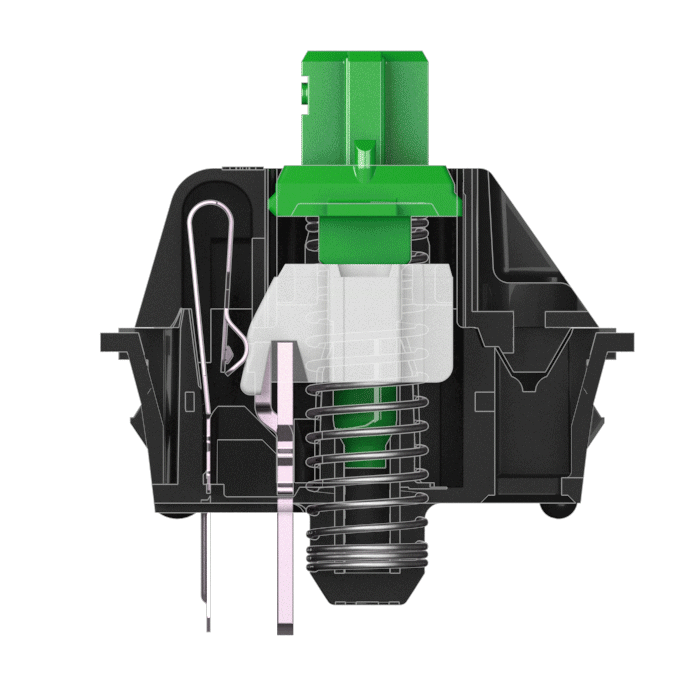

Sound abspielen
Cherry MX Green sind wie Cherry MX Clear, ziemlich selten in Gebrauch. Das Funktionsprinzip ist das gleiche wie bei Cherry MX Blue, nur die Feder ist fester. Wie beim Cherry MX Clear lohnt sich der Kauf einer Tastatur mit grünen Schaltern in zwei Fällen: Erstens, wenn sicher ist, dass die blauen Schalter nicht elastisch genug für Sie sind und wenn sie etwas Neues ausprobieren möchten. Der Vorteil solcher Schalter ist, wie auch bei den anderen festen Varianten, dass versehentliche Anschläge auf ein Minimum reduziert werden. Wir empfehlen, schallabsorbierende Ringe für eine solche Tastatur zu kaufen: damit kann man die Lautstärke deutlich reduzieren.
- Für Fans von mechanischen Tastaturen, die deren Sound kennen und mögen
- Für “Tastenklopfer”
- Für diejenigen, die nicht ohne “Klicks” können oder wollen
Cherry MX Speed Silver (linear)
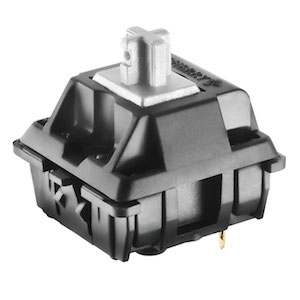
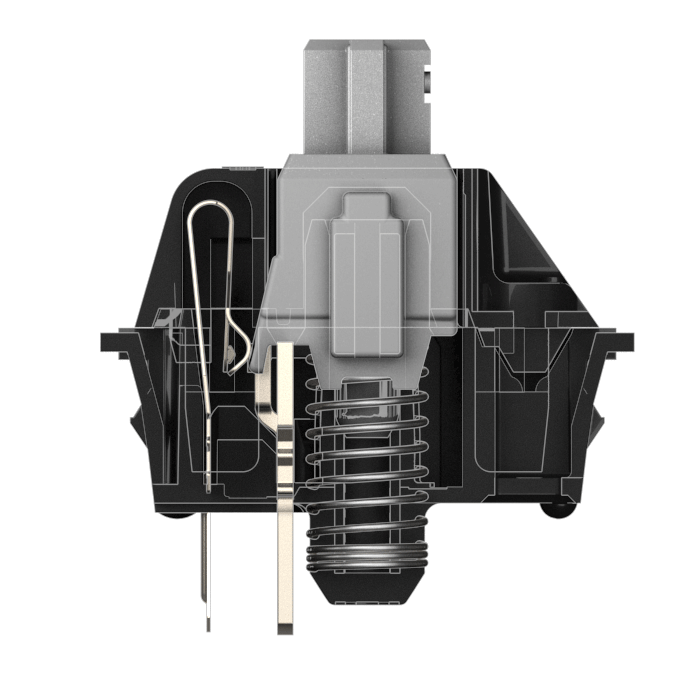
Sound abspielen
Vorgestellt im Jahr 2015: Cherry MX Speed Silver hat das gleiche Funktionsprinzip wie Cherry MX Red, aber mit einem verkürzten Tastenzug. Im Inneren wird der Kontakt in dem Teil geölt, der mit dem Schaft in Berührung kommt, wodurch das Tippen als besonders “smooth” und geschmeidig empfunden wird. Er gilt als der schnellste Cherry MX-Schalter. Aufgrund des um 40 % reduzierten Tastenhubs vor dem Auslösen (1,2 mm gegenüber 2 mm bei Standard-Schaltern) ist er gut für Spieler geeignet, die eine maximal schnelle Reaktion auf das Drücken brauchen, oder auch für diejenigen, bei denen der lange Hub herkömmlicher Schalter das Tippen deutlich verlangsamt. Die Schalter fühlen sich beim Benutzen sehr dynamisch an.
- Für schnelle Spieler
- Für schnelle Tipper
- Für die Sammlung
- Fürs Office
Cherry MX Naturweiß (linear)

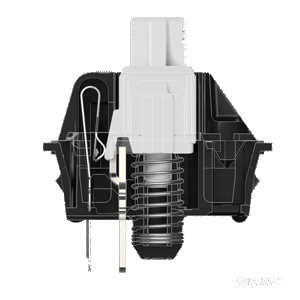

Sie wurden erstmals im Oktober 2015 in Ducky Shine 5-Tastaturen vorgestellt: Die Hauptzielgruppe dieser Schalter sind Gamer, für die Cherry MX Red zu leicht sind und deren Finger beim Cherry MX Black schnell an Kraft verlieren. Cherry MX Nature White ist nicht zu schwer und nicht zu leicht, es ist die goldene Mitte: 52 Gramm Widerstandsgewicht vor dem Auslösen, im Gegensatz zum Red(45 Gramm) und zum Black (60 Gramm). Im Netz hört man oft die Prognose, dass sie eines Tages zum Standard-Switch in der Welt der Gamer werden.
- Spieler, denen es schwerfällt, sich zwischen Cherry MX Red und Black zu entscheiden
- Jahrelange Fans von Linearschaltern
- “Druckkraft-Liebhaber”
- Für die heimische Sammlung
- Fürs Office
Topre

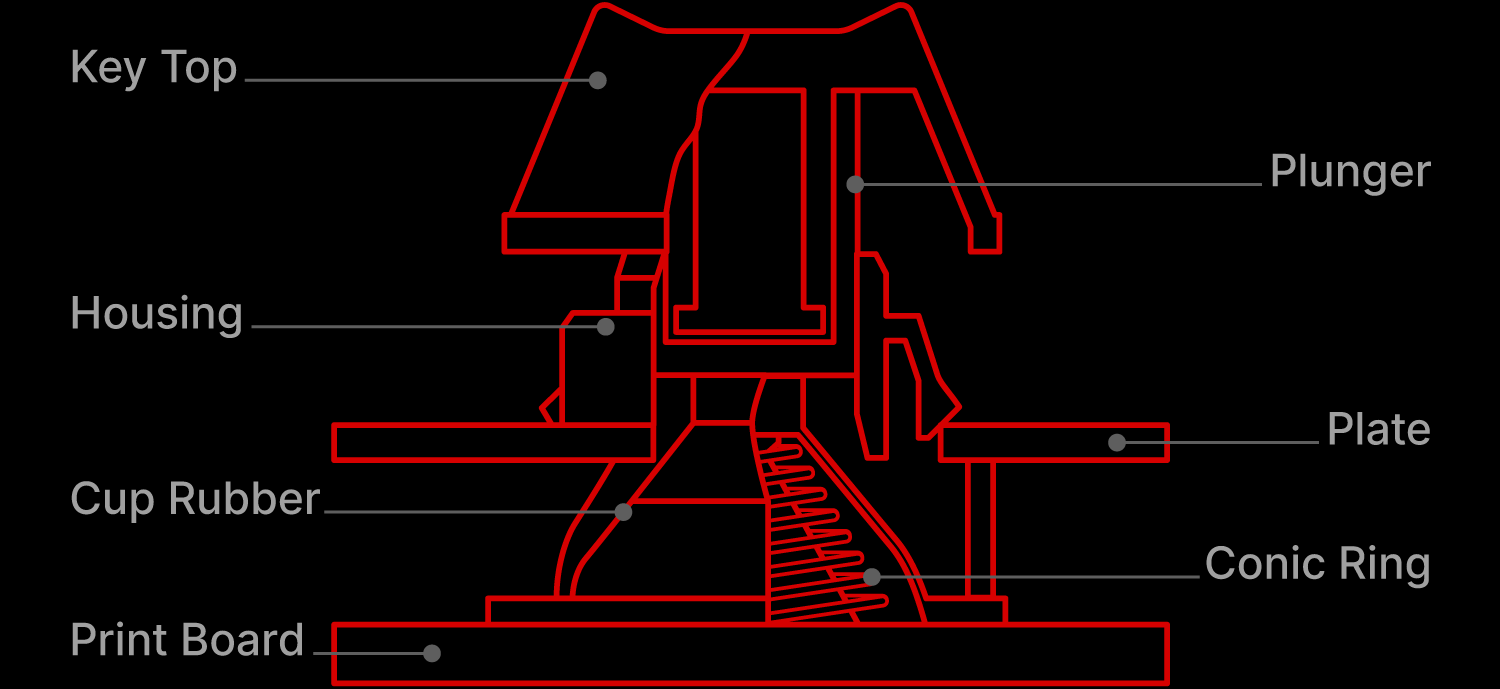
Topre-Schalter sind elektrostatische kapazitive Schalter der japanischen Firma Topre Corporation. Die Topre-Tastatur wurde erstmals 1983 eingeführt. Der Topre-Schalter hat folgenden Aufbau: Die Taste befindet sich auf einer gewölbten Gummidichtung, darunter befindet sich eine konische Stahlfeder. Die Feder selbst befindet sich wiederum direkt über der Leiterplatte. Trotz der Tatsache, dass solche Schalter separate Komponenten der Tastatur sind, werden sie alle zusammen auf eine Platte montiert. Die Gummikuppel sorgen für den größten Teil des Widerstands und der Taktilität.
Man muss sich keine Sorgen machen, dass die Gummidichtung nicht richtig funktioniert oder ihre Beschaffenheit einbüßt, wie man es möglicherweise von weniger qualitativen Membrantastaturen kennt: Tastaturen mit Topre-Schaltern dienen seit Jahrzehnten vielen glücklichen Besitzern. Zu welcher Kategorie gehören Topre-Schalter? Die Struktur der Schalter ist eine Art „Hybrid“: Da eine Gummimembran in ihrem Aufbau enthalten ist, ist es nicht wirklich möglich, sie eindeutig den „Mechanischen“ zuzuordnen - selbst der Begriff „halbmechanisch“ ist nicht unbedingt ganz richtig. Man kann sie aber auch nicht "Membran" nennen – denn sie hat Federn. Wir haben es also wirklich mit einem Mischmodell zu tun.
Topre 45 g

Die Topre-Schalter fühlen sich zunächst wie eine verbesserte Version der Membranschalter an. Dann kommt es einem wiederum so vor, als würde man mit mechanischen Schaltern wie dem Cherry MX Red oder Alps SKCM Cream Damped arbeiten. Der Tastenhub ist sehr flüssig und der taktile Punkt befindet sich fast am Anfang des Zuges. Nach seiner Überwindung gibt es fast keinen Widerstand mehr, wodurch die Tasten während des Schreibens in der Regel bis zum Anschlag eingedrückt werden. Der Triggerpunkt liegt in der Mitte des Zuges, aber man spürt ihn kaum. Wenn der Schalter ganz durchgedrückt wird, ertönt ein charakteristischer und klangvoller „Zack”-Ton, so auch, wenn er in die ursprüngliche Position zurückkehrt.
Im Allgemeinen sind sich die Benutzer einig, dass Topre-Schalter leiser als die meisten mechanischen Schalter sind und einen angenehmen Klang haben. Dadurch und durch das fehlende taktile Feedback können unerfahrene Benutzer zu Anfang ab und an versehentlich auf nebenliegende Tasten drücken. Das gilt besonders bei Tastaturen wie RealForce, die Schalter mit unterschiedlicher Druckstärke für verschieden Finger haben.
- Anspruchsvolle Benutzer, die wissen, was sie wollen
- Für “Vielschreiber”
- Für die Sammlung
- Fürs Büro, auch für nervige Kollegen
- Für Zuhause
ALPS SKCL/SKCM
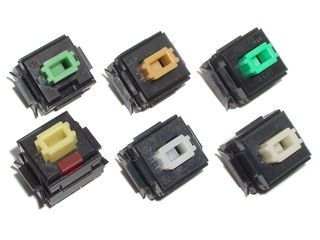
ALPS-Schalter für mechanische Tastaturen wurden bis 1996 von der gleichnamigen japanischen Firma hergestellt: Zurzeit sind alle Schalter, die sich ALPS oder Alps nennen, mal mehr, mal weniger gute Kopien dieser sehr alten ALPS. Die Originalschalter werden in ausländischen Quellen häufig als „Alps Complicated“ (Komplex) bezeichnet, wegen ihrem Aufbau, der aus 10 Teilen pro Schalter besteht. Es gibt lineare, taktile, klickende und andere Optionen für Alps-Schalter.
Die beliebtesten Klone sind derzeit die Matias-Schalter, deren Aufbau im Vergleich zum Original stark vereinfacht ist. Wenn Sie kein echter Fan sind, ist es nicht sinnvoll, andere ALPS-Klone zu beachten.
Der ALPS (und ähnliche) kann eine großartige Alternative zu Cherry MX-Schaltern sein: Wenn man Taktilität mag und etwas mehr als den Cherry MX Brown und den Cherry MX Clear will, dann ist ALPS genau das richtige. Trotz der Tatsache, dass ALPS-Schalter für mechanische Tastaturen derzeit nicht mehr verfügbar sind, findet man solche Tastaturen - mit genügend Ausdauer - in gutem Zustand im Internet, beispielsweise bei eBay.
- Für Experimentierfreudige
- Falls Cherry MX einfach nicht das Richtige ist
- Um den Horizont zu erweitern
- Für die Heimsammlung
Matias

Einige der bekanntesten ALPS-Klone sind auf der Matias-Tastatur installiert: Sie werden in China von der Firma Gaote (Dongguan Gaote Electronics Co., Ltd.) hergestellt. Der Aufbau der Matias-Schalter ist im Vergleich zum ursprünglichen ALPS erheblich vereinfacht.
ALPS Matias
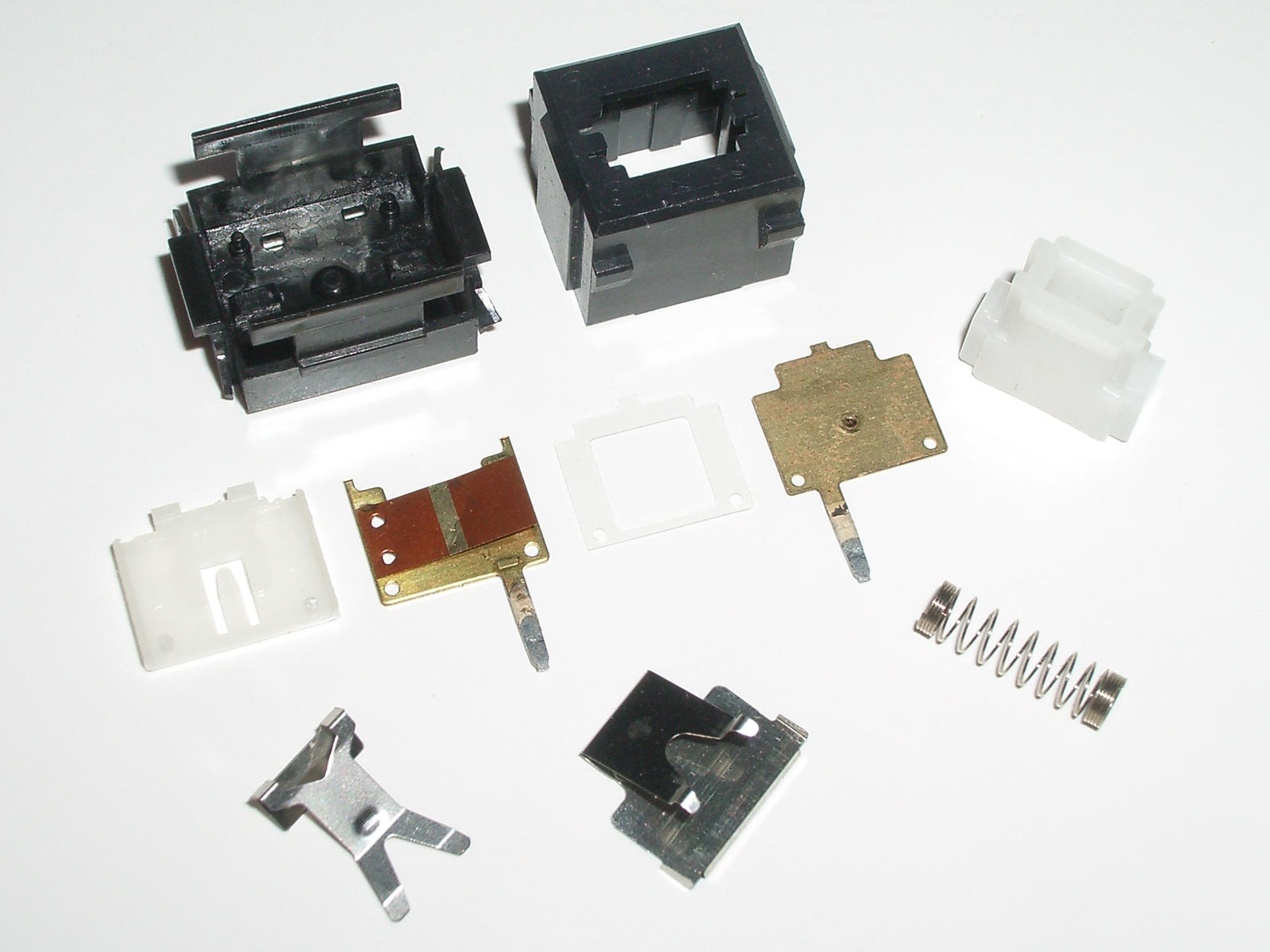
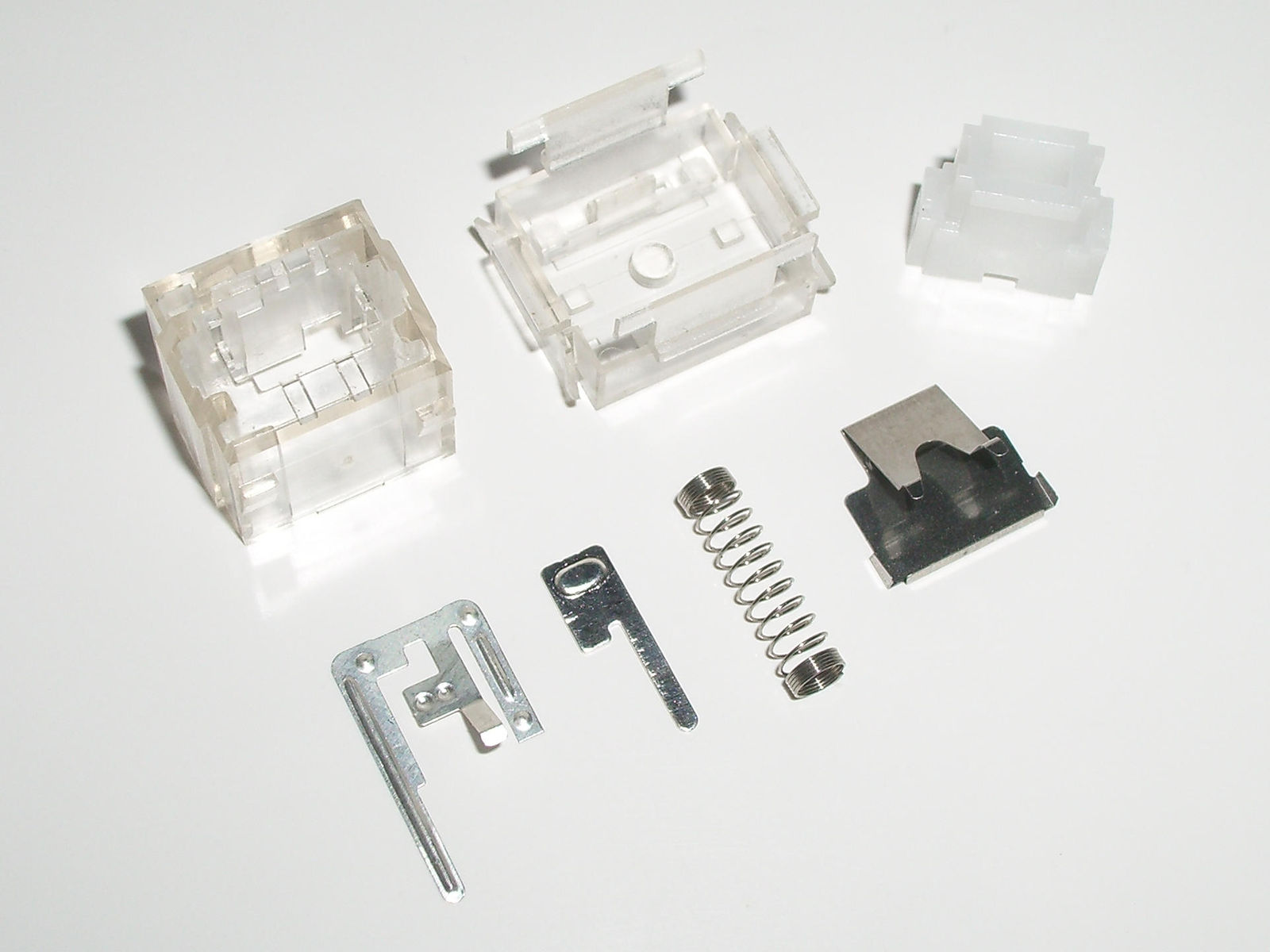
Sie haben ein vollständig transparentes Gehäuse, mit dem man die LEDs direkt auf der Platine unter dem Schalter installieren kann, wie es auch beim Cherry MX RGB der Fall ist.
Mechanische Matias-Schalter gibt es in drei Varianten: klickend (clicky), taktil (tactile/quiet click) und linear. Wie beim Cherry MX unterscheiden sich die Schaltertypen optisch in den Stielfarben. Er fühlt sich fester und “deutlicher” an als der Cherry MX: Das Drücken erfordert mehr Aufwand, aber das taktile Feedback und das Klicken sind viel klarer und stärker (etwa so, als würde man Cherry MX Brown und Cherry MX Clear vergleichen). Einige Nutzer sagen, dass nach Matias alle Cherry MX fast linear erscheinen. Ein weiterer wichtiger Unterschied besteht darin, dass der Widerstand des Schalters nach dem Auslösen der Taste nachlässt, was dazu beiträgt, dass die Taste bis zum Ende gedrückt wird. Für diejenigen, die es gewohnt sind, die Taste nicht vollständig runterzudrücken, kann diese Eigenschaft irritierend sein.
Matias Click (taktil, klickend)
Schalter mit einem klaren, deutlichen Klick: auf jeden Fall nicht das Leiseste und daher nicht für Menschen mit empfindlichen Ohren geeignet. Besonders für den Büroeinsatz nur mit großer Vorsicht einzuplanen. Widerständiger als Cherry MX: Ihr Klick ist lebendiger und "saftiger". Der Triggerpunkt ist etwas höher als beim Cherry MX Blue: das wird von einigen als deutlicher Vorteil eingeschätzt.
- Menschen, die gerne “in die Tasten hauen”
- Für Schreibmaschinen-Nostalgiker
- Für Aufgeschlossene und Neu-Gierige
- Für die Heimsammlung
Matias Quiet Click (taktil)
Bei der Entwicklung dieser Schalters hat Matias versucht, sie so leise wie möglich zu machen. Es stellte sich heraus, dass ihr Klang aufgrund der geräuschabsorbierenden Dichtungen im Schalter, mit einer Membrantastatur zu vergleichen ist. Tatsächlich ist das Wort "Klick" im Namen, nicht wortwörtlich zu verstehen: Der Schalter ist nicht klickend (sonst wäre es sinnlos, ihn extra leise zu machen), sondern taktil. Es fühlt sich ungefähr wie Cherry MX Brown an, aber wie andere Matias-Schalter auch sind sie fester und das taktile Feedback ist klarer.
- Nutzer, die gerne “in die Tasten hauen”
- Für diejenigen, die die Taktilität des Cherry MX Brown vermissen
- Für Aufgeschlossene und Neu-Gierige
- Für die Heimsammlung
Matias Quiet Linear (Linear)
Matias-Linearschalter fühlen sich sanfter und enger an als Cherry MX Silent Red, ansonsten sind sie sich sehr ähnlich. Matias Quiet Linear sind sehr leise im Vergleich zu herkömmlichen Schaltern ohne Schallpads und passen daher perfekt in das Büro und nachhause zum Spielen. Diese Schalter werden oft mit Topre vergliechen.
- Nutzer, die richtiges “Tastenklopfen” lieben
- Für Neu-Gierige
- Fürs Office
- Für die Heimsammlung
Kailh
Günstige chinesische Cherry MX Switch Klone: Sie wurden vor relativ kurzer Zeit in den Markt eingeführt und sind daher im Vergleich zu den seit dreißig Jahren bekannten Cherry noch nicht gut genug erprobt und getestet, um ihre Qualität eindeutig beurteilen zu können.

Der Zug fühlt sich weniger gleichmäßig und “glatt” an. Der Druck ist “rau” (oft findet man das Wort "sandig" in den Bewertungen). Bei Tastaturen mit Kailh-Schaltern trifft man häufig auf „Rasseln“ oder „Doppelklicken“, wenn beim Drücken anstelle einer, zwei Buchstaben gleichzeitig getippt werden. Es ist allerdings zu beachten, dass der Preis für mechanische Tastaturen von Kailh erheblich niedriger ist.
Im Allgemeinen ist der Vergleich zwischen Cherry und Kailh nicht ganz zutreffend, da es sich um Schalter aus unterschiedlichen Preiskategorien handelt. Wenn man eine preiswerte mechanische Tastatur für dreißig bis vierzig US-Dollar kauft, ist Kailh ziemlich gut, denn niemand wird für diesen Preis ein Wunder der Mechanik erwarten. Anders ist es, wenn man sich für ein Premium-Tastaturmodell für 100 bis 150 US-Dollar entscheidet. Aus unserer Sicht lohnt es sich, solche Tastaturen genauer zu betrachten, denn für dieses Geld gibt es viele hochwertige und interessante Optionen.
Um zu Argumentieren, zeigen wir Ihnen ein Beispiel für schlechte Verarbeitungsqualität (möglicherweise treten solche Probleme nicht bei allen Kailh-Schalter auf):
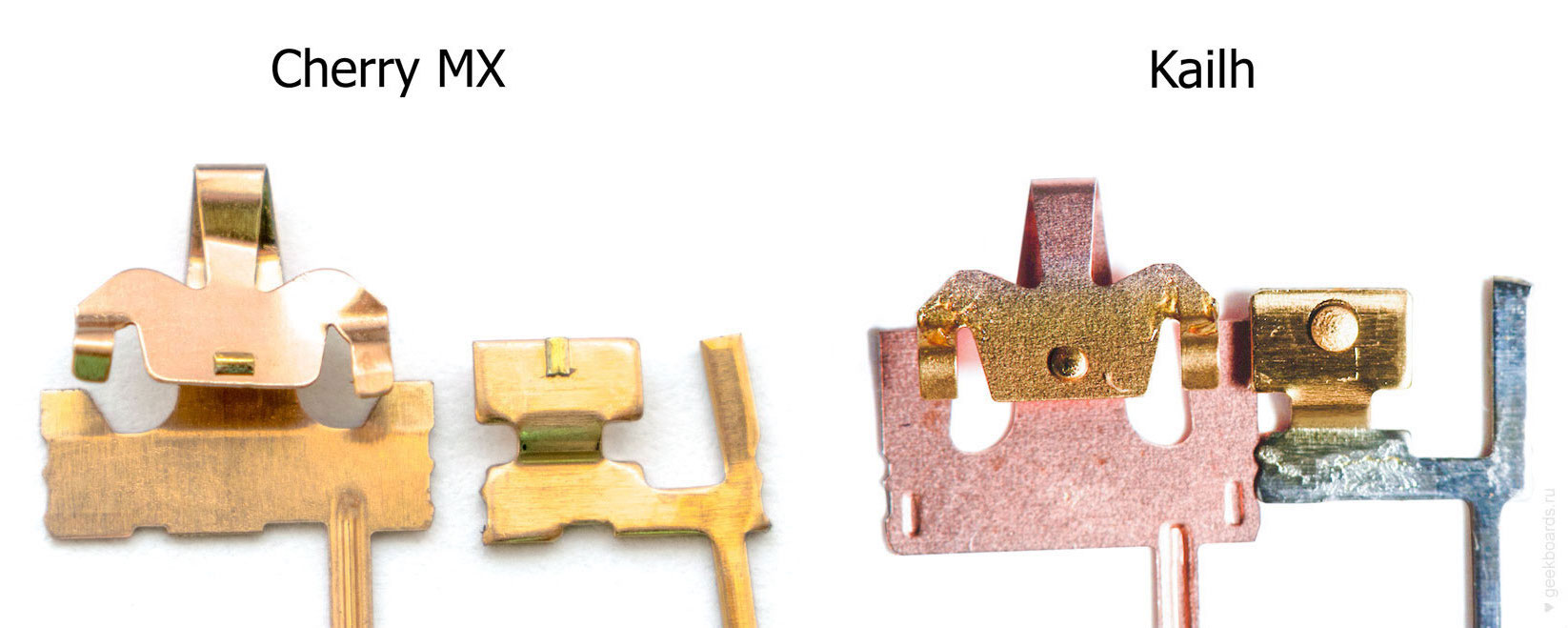
Erwähnenswert ist, dass die Qualität der Kailh-Schalter sich von Jahr zu Jahr verbessert. Die ersten Versionen waren wirklich sehr schlecht, aber im Laufe der Zeit gibt es immer weniger negative Bewertungen.
Kailh Brown (taktil)
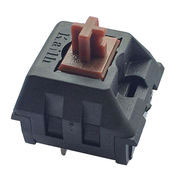
Klone von Cherry MX Brown: Benutzungsgefühl und Druck ähnlich wie das Original (siehe Cherry MX Brown).
Kailh Blue (taktil, klickend)
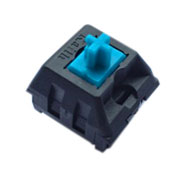
Klone von Cherry MX Blue: Benutzungsgefühl und Druck ähneln dem Original (siehe Cherry MX Blue).
Kailh Red (linear)
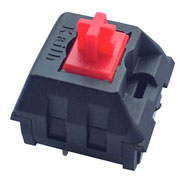
Klone von Cherry MX Red: ähneln in ihrer Haptik und ihrem Druckwiderstand dem Original (siehe Cherry MX Red).
Kailh Black (linear)
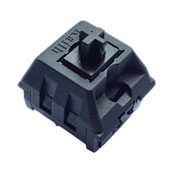
Klone vom Cherry MX Black: sie ähneln in ihrer Haptik und ihrem Druckwiderstand dem Original (siehe Cherry MX Black).
Razer

Razer-Switches sind Klone der Cherry MX-Switches. In den Jahr 2014 bis 2015 war der Markt für mechanische Tastaturen mit einem Mangel an Cherry MX-Schaltern konfrontiert: Cherry verfügte nicht über genügend Produktionskapazitäten, um die wachsende Nachfrage nach den Schaltern auszugleichen. Daher mussten die Hersteller nach anderen Optionen suchen. Zuallererst war das der Hauptgrund für den Übergang vieler Unternehmen - einschließlich Razer - von Cherry MX zu ihren chinesischen Nachahmer - und nicht etwa der Wunsch nach Senkung der Produktionskosten. Gegenwärtig gibt es mindestens zwei Hersteller von Razer-Schaltern: Kaihua (produziert Kailh-Schalter) und Greetech. Gerüchten zufolge sind alle Tastaturen ab Ende 2015 mit Schaltern von Greetech ausgestattet. Wiederum wird gemunkelt, dass Razer auf Kailh-Schalter wegen nicht ausreichender Qualität verzichtet hat. Die Hauptkritik bei Razer-Switches bezieht sich auf die Inkonsistenz der Verarbeitung: Das Tippen kann sich von Schalter zu Schalter unterscheiden; einige klicken lauter, andere sind kaum hörbar. Einige haben einen soften Zug, andere nicht.
Razer Green (taktil, klickend)
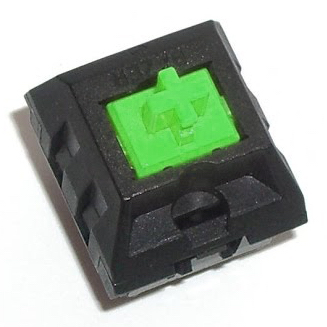

Etwas weniger taktile Reaktion als beim Cherry MX Blue. Ansonsten fast das gleiche Tippgefühl.
Razer Orange (taktil)
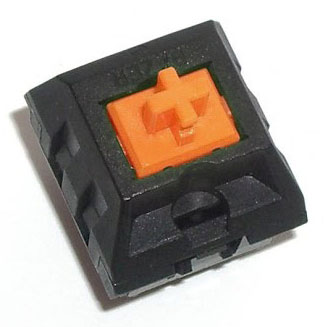

Wie beim Razer Green ist die taktile Reaktion im Vergleich zum Cherry MX Brown weniger klar und das Tippen fällt etwas leichter.
Razer Yellow (linear)
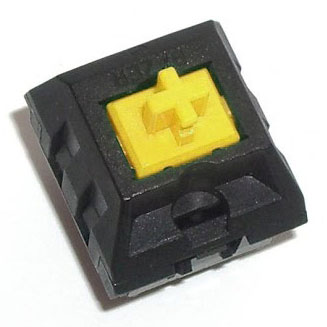
Sehr ähnlich wie der Cherry MX Speed Silver: der gleiche verkürzte Tastenhub und der gleiche Kraftaufwand beim Drücken einer Taste. Nicht so glatt wie Cherry MX, manchmal spürt man beim Tippen "SAND", aber nicht immer.
Gateron
Vielleicht die bekanntesten, beliebtesten und qualitativ hochwertigsten Cherry MX-Klone: beliebt vor allem für ihre durchgängig identische Qualität (die Schalter sind in Qualität und Haptik beim Drücken identisch) und für seinen gleichmäßigen, feinen Tastenhub, sogar im Vergleich zu Cherry MX. Unter den Mängeln - der Stiel am Gateron baumelt viel deutlicher als am Cherry, weshalb taktile und klickende Gaterons trotz des feinen Gangs, in ihrem Klang, nervig sein können.

Die Farben der Stiele stimmen in den Parametern nicht mit den Cherry-Schaltern überein. Beispielsweise ist Gateron Clear linear, während Cherry MX Clear taktil ist. Unten findet sich eine Vergleichstabelle von Gateron und Cherry MX.
|
Schalter |
Typ |
Bestätigung |
Cherry |
|
Gateron Clear |
linear |
35g |
-- |
|
Gateron Red |
linear |
45g |
MX Red |
| Gateron Yellow | linear |
50g |
-- |
|
Gateron Black |
linear |
65g |
MX Black |
|
Gateron Blue |
klickend |
55g |
MX Blue |
|
Gateron Green |
klickend |
75g |
MX Green |
|
Gateron Brown |
taktil |
50g |
MX Brown |
Zealio
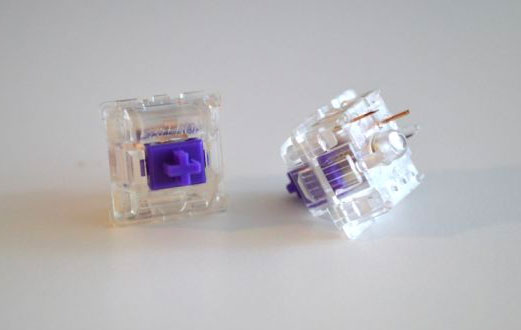
Zealio-Schalter erschienen größtenteils durch Anregung der Community: Viele Leute mögen die klare taktile Reaktion der Cherry MX Clear-Schalter, aber für andere ist der Druck zu schwerfällig. Aus diesem Grund entschied sich Zeal PC, den idealen Switch zu machen: Sie werden am selben Ort wie Gateron hergestellt und sind faktisch Gateron. Die einzigen Unterschiede zum Standard-Gateron (außer der Reaktionskraft) sind vergoldete Federn, die keiner Korrosion unterliegen, und eine ausgeprägtere taktile Reaktion, die durch die Verwendung einer "eckigeren" Stabform erreicht wird:
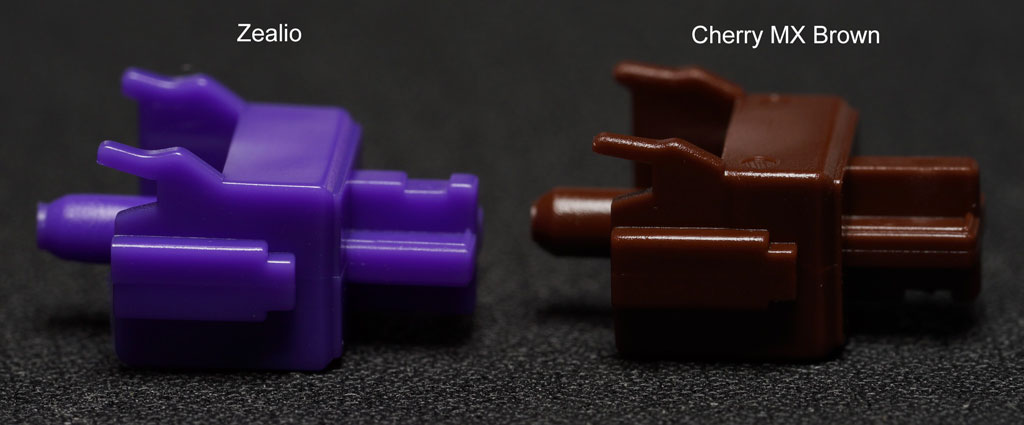
Die Schalter erwiesen sich als Durchbruch: ein sehr feiner Zug, eine ausgezeichnete taktile Reaktion und eine ausgeglichene Reaktionskraft. Die Community liebt sie so sehr, dass sie fast immer ausverkauft sind, oft bekommt man die Zealios nur auf Vorbestellung - außerdem sind sie ziemlich teuer.
Outemu
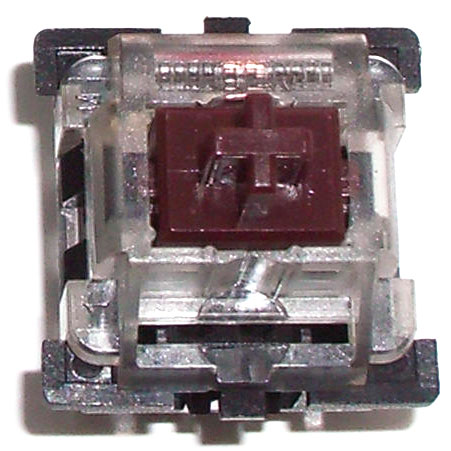
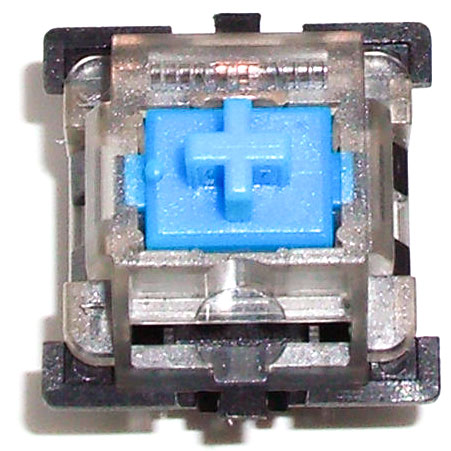
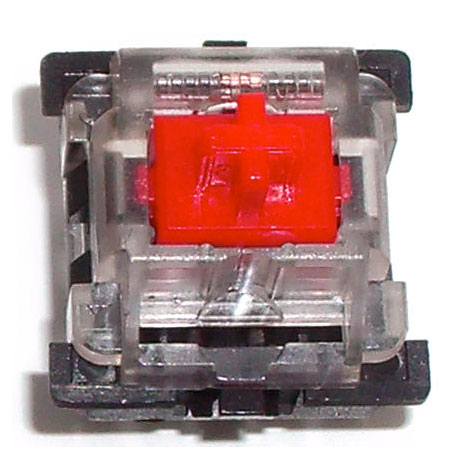
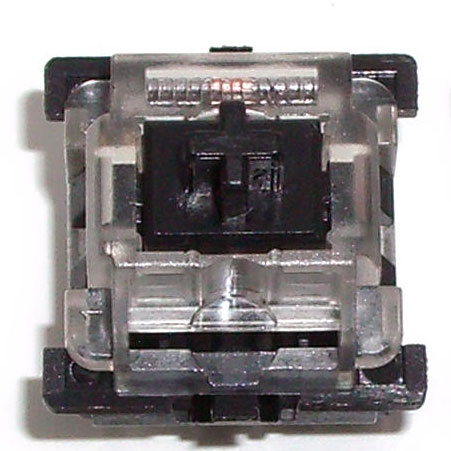
Ein weiterer chinesischer Cherry MX-Switch-Klon: Es ist einer der kostengünstigsten mechanischen Schalter, die außerhalb Chinas bekannt sind. Dank ihrer Verwendung in Motospeed - das sind sehr günstige chinesische Tastaturen, die für 30 US-Dollar erhätlich sind, sind sie überaus populär geworden. Für dieses Geld ist allerdings keine gute Qualität zu erwarten. Das Hauptproblem ist die Inkonsistenz in der Verarbeitung: Schalter derselben Farbe auf derselben Tastatur können sich in Druckstärke, Klang und Tippgefühl unterscheiden (auch bei anderen chinesischen Schaltern ist das, ein häufiges Problem). Über die schlechte Qualität des Kunststoffs und schmelzende Kontakte muss man erst gar nicht sprechen.
Die Farben sind die gleichen wie bei Cherry MX: Es gibt braune, blaue, rote und schwarze Schalter. Taktil, klickend bzw. linear. Im Gegensatz zu Cherry ist Outemu fester.
Nach unserer sehr subjektiven Meinung ist es sinnvoller, ein paar Dutzend Dollar dazuzulegen um zumindest eine Kailh-Tastatur zukaufen.



